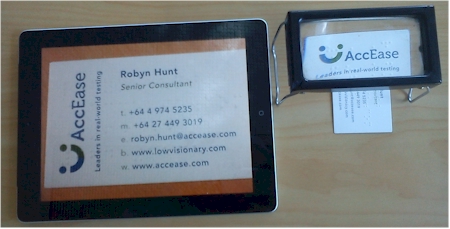My family has always been technically inclined. Growing up we always had gadgets and machinery around. Home movies exist of our family since before I can remember. Dad took up video technology in his seventies. We had a huge freezer and a dishwasher before most other people. Mum had modern sewing machines and for a short while she had a knitting machine. When I showed her my iPad earlier this year, at ninety four she was more interested in it than the photographs I was showing her!
The farm I grew up on has always had good up to date technology and machinery. Dad and my brother shared a love of machinery.
Childhood technology
So it wasn’t surprising that my parents looked to technology to help me as a child. There was very little available then, and we had no access to support. I have always been quite low tech as a result. I finally had, at age eight a little stand magnifier, which still couldn’t enlarge maths texts enough for me to read properly and understand. I also had a cumbersome big magnifier with a light which was generally useless. The little one was good for making fish eyes in class during boring maths. I still very occasionally use it to read printed documents. The big one got ditched years ago.

Stand magnifier showing enlarged text.
I won’t comment on the numerous and varied pairs of specs I have worn since I was two, (The latest pair features in the banner on the blog.) In my teens Dad bought me a very good little pair of binoculars I could carry in my handbag. I used them as opera glasses and they travelled the world with me until I acquired a monocular sometime in the eighties.
The computer age
Then came computers. It took some time for enlargement and colour contrast and other features I could use to become available. The technology was expensive, seemed complex, was not always very compatible with anything else, and there was little if any training available to help me learn to use either the computer or the assistive technology. I had used typewriters, ancient and modern, manual and electric, and a cassette recorder for many years, but you can’t enlarge type on a typewriter.
Over the years I have struggled to read print, but other options such as a screen reader always seemed to be too expensive and hard to learn for someone who still has useful vision. The quality of printers has improved a great deal as well. When I find old typewritten or dot matrix printed documents I wonder how I ever read them.
I have used PCs and laptops with varying degrees of success, especially appreciating large screens, improved resolution, and better browsers. Never did get any proper training though.
Praise the iPad
To date the iPad is the best of the lot. Laptops are heavy and I can’t get close enough to the screen. The iPad is lighter than a laptop, smaller and much easier to see for me. It has good resolution, and enlarges beautifully. It is my notebook, diary and address book. I can read reports, and books if I want. I can create documents, take photos, collect emails, indulge in social media, watch videos and much more. And I bought it at the local electronics shop with no need of “special” add-ons and for the same price as the average punter!
Universal design rules
Years ago I was involved with the Technical Aid Trust, a group of well- disposed, generous and committed techies who worked with disabled people to develop ways for them to interact with computers. They believed in the principles of universal design, and their vision is being realised today with mainstream devices such as the iPad.

iPad alongside stand magnifier showing comparison of enlarged text.
Smaller in price and size
How far we have come and what a journey. Assistive tech used to cost the earth, thousands of dollars, now it is much more affordable, often in the hundreds of dollars. You had to mount a major fundraising campaign just to buy something that would be obsolete in a few short years. And we have gone from huge and cumbersome machines to multi-functional devices that fit in my handbag, and are lighter than my old diary. Open-source software is readily available, along with cheap accessible apps.
Valuing the difference
I love the divergence and convergence of tech. I love the way deaf/blind people can read braille display, the way blind people can have electronic access to so much more printed material, and Deaf people can celebrate their beautiful Sign Language on video, with transcripts and captions for non-signers. People with dyslexia can have highlighting speech software, and web sites can be built in creative easy read. I wish employers and other information providers could celebrate and value this rich creative diversity, and see us as an asset instead of a problem.
Measuring progress
In thinking of progress I used to use the example of my grandmother who lived to witness both the first manned flight, and the moon landing. Now I think I could equally say from that little magnifier to the high tech iPad. If I live as long as she did I wonder what tech changes I have yet to experience. Bring it on I say!













